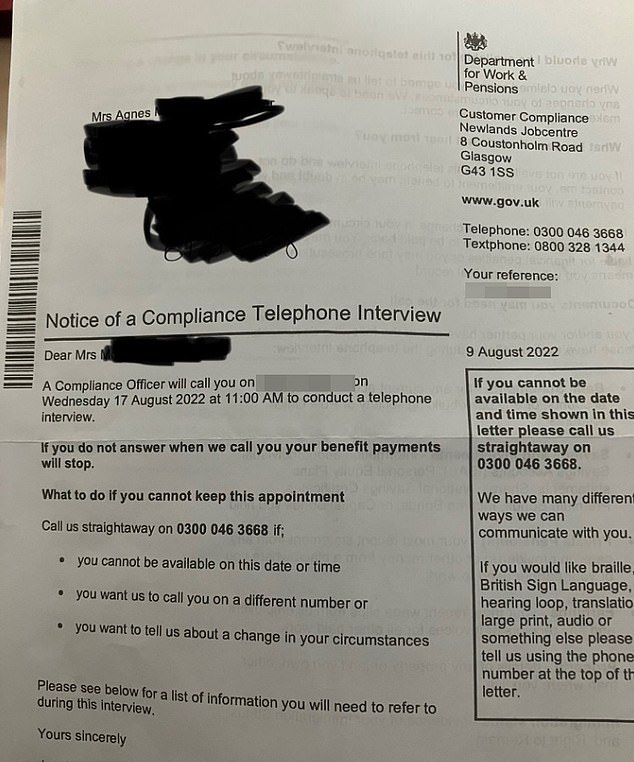DWP Cuts Benefits: Letter Notifications & Next Steps For Claimants

Table of Contents
Understanding Your DWP Benefit Cut Notification Letter
Receiving a letter indicating a reduction in your DWP benefits can be confusing and upsetting. Understanding the contents of the letter is the first crucial step.
Key Information to Look For:
- The specific reason for the benefit reduction: The letter should clearly state why your benefits are being reduced. This might involve a change in your circumstances, a reassessment of your eligibility, or an error in your original claim.
- The amount of the reduction and its effective date: Note the precise amount by which your benefits will be reduced and when this reduction will take effect. This information is vital for budgeting and planning.
- Your right to appeal the decision and the deadline for doing so: The letter will outline your right to challenge the decision and the timeframe within which you must do so. Missing this deadline could significantly impact your ability to appeal.
- Contact details for further inquiries and support services: The letter should provide contact information for the DWP, allowing you to seek clarification or further information if needed.
The letter often cites specific regulations or assessments that led to the benefit cut. For example, a reduction in Universal Credit might be due to a change in your employment status or a reassessment of your household income. Carefully reviewing every detail in the letter is crucial to understanding the rationale behind the decision. Common reasons for benefit reductions include:
- Changes in personal circumstances (e.g., marriage, change in employment, moving house)
- Reassessments of eligibility (e.g., changes in health condition, reassessment of disability needs)
- Errors in the original claim or subsequent updates
It is important to understand that DWP benefit cuts can affect various benefits, including Universal Credit, Employment and Support Allowance (ESA), Personal Independence Payment (PIP), and others. Each benefit has specific criteria and regulations; refer to the official government websites for detailed information on each.
Types of DWP Benefit Cuts:
DWP benefit cuts can impact a range of benefits, affecting individuals and families across the UK. Here are some examples:
- Universal Credit (UC): Reductions can occur due to changes in income, household composition, or work status.
- Employment and Support Allowance (ESA): ESA payments might be reduced or stopped if a claimant's health condition improves or if they fail to meet work-related activity requirements.
- Personal Independence Payment (PIP): PIP payments can be reduced or stopped following a reassessment if a claimant's needs are deemed to have changed.
- State Pension: While less common, reductions can occur due to errors in calculations or changes in legislation.
For detailed information on specific benefits and potential reasons for cuts, consult the official government websites for each program.
Next Steps After Receiving a DWP Benefit Cut Letter
Acting promptly and decisively after receiving a DWP benefit cut letter is crucial. Here's a structured approach to navigating this challenging situation.
Gather Your Evidence:
Building a strong case requires meticulous evidence gathering. This might seem daunting but is essential for a successful appeal.
- Collect any supporting documentation relevant to your claim: This could include medical reports from your GP or specialist, payslips, bank statements, tenancy agreements, and any other documentation that supports your claim and contradicts the reason for the benefit cut.
- Keep copies of all correspondence with the DWP: Maintaining a record of all communication with the DWP is essential for tracking the progress of your case and providing evidence should you need to appeal.
The importance of proactive evidence gathering cannot be overstated. Accurate and organized documentation is vital in supporting your appeal against the DWP benefit cut. Make sure all your evidence is clear, legible, and easy to understand.
Understanding Your Appeal Rights:
The DWP provides a clear process for challenging their decisions. Understanding your rights and the steps involved is critical.
- Mandatory Reconsideration: This is the first stage of the appeal process. You'll need to formally request a reconsideration of the decision, providing all relevant evidence.
- Appeal to an Independent Tribunal: If you're unhappy with the outcome of the mandatory reconsideration, you can appeal to an independent tribunal. This involves a hearing where you can present your case.
- Legal Aid and Support Organizations: Several organizations offer legal aid and support to individuals appealing DWP decisions. Their assistance can be invaluable in navigating the complexities of the appeals process.
Acting promptly is critical; there are strict time limits for each stage of the appeal process. Missing these deadlines can jeopardize your appeal. Consult the information provided in your letter and relevant government websites for accurate timelines.
Seeking Support and Advice:
You're not alone in this process. Numerous resources and support networks are available.
- Relevant charities and support organizations: Several charities specialize in providing advice and assistance to individuals facing DWP benefit cuts. They can offer guidance, support with completing forms, and representation at appeals.
- Legal professionals specializing in benefits appeals: Solicitors and barristers with expertise in social security law can provide expert legal advice and representation throughout the appeals process.
Remember, seeking support is not a sign of weakness but a proactive step towards protecting your rights and ensuring a fair outcome. Don't hesitate to utilize the available resources and assistance.
Conclusion
Receiving a DWP benefit cut letter is a significant event demanding prompt and informed action. Understanding your rights, gathering necessary evidence, and seeking support are crucial steps in navigating this challenging situation. Don't delay; review your letter carefully, gather your evidence, and explore your appeal options immediately.
Don't face DWP benefit cuts alone. Find the support you need and challenge the decision if you believe it's unfair. Learn more about your rights regarding DWP benefit cuts and find support from reputable organizations. Remember to act quickly to meet all deadlines. Your access to vital financial support depends on your timely and informed response. Find the help you need and challenge any unjust DWP benefit cuts today. [Link to relevant government resource] [Link to support organization]

Featured Posts
-
 Xrp Investment Surge Trumps Influence And Institutional Adoption
May 08, 2025
Xrp Investment Surge Trumps Influence And Institutional Adoption
May 08, 2025 -
 Shkelje Te Rregullave Te Uefa S Hetimi Ndaj Arsenalit Pas Ndeshjes Me Psg
May 08, 2025
Shkelje Te Rregullave Te Uefa S Hetimi Ndaj Arsenalit Pas Ndeshjes Me Psg
May 08, 2025 -
 Central Cordoba Fortaleza Institucional En Su Estadio El Gigante De Arroyito
May 08, 2025
Central Cordoba Fortaleza Institucional En Su Estadio El Gigante De Arroyito
May 08, 2025 -
 Psgs Doha Labs First Step Towards Worldwide Innovation
May 08, 2025
Psgs Doha Labs First Step Towards Worldwide Innovation
May 08, 2025 -
 Psg Angers Maci Canli Izle Hangi Kanalda Ve Nasil
May 08, 2025
Psg Angers Maci Canli Izle Hangi Kanalda Ve Nasil
May 08, 2025
Latest Posts
-
 Anchorage Witnesses Second Major Anti Trump Protest In Two Weeks
May 09, 2025
Anchorage Witnesses Second Major Anti Trump Protest In Two Weeks
May 09, 2025 -
 Anchorage Welcomes Candle Studio Alaska Airlines Lounge Korean Bbq And Eye Tooth Restaurant
May 09, 2025
Anchorage Welcomes Candle Studio Alaska Airlines Lounge Korean Bbq And Eye Tooth Restaurant
May 09, 2025 -
 Anchorage Opens New Candle Studio Alaska Airlines Lounge Korean Bbq And Eye Tooth Restaurant
May 09, 2025
Anchorage Opens New Candle Studio Alaska Airlines Lounge Korean Bbq And Eye Tooth Restaurant
May 09, 2025 -
 Reaching Nome The Challenges Faced By First Time Iditarod Mushers
May 09, 2025
Reaching Nome The Challenges Faced By First Time Iditarod Mushers
May 09, 2025 -
 Iditarod 2024 Following Seven Rookie Teams To Nome
May 09, 2025
Iditarod 2024 Following Seven Rookie Teams To Nome
May 09, 2025
